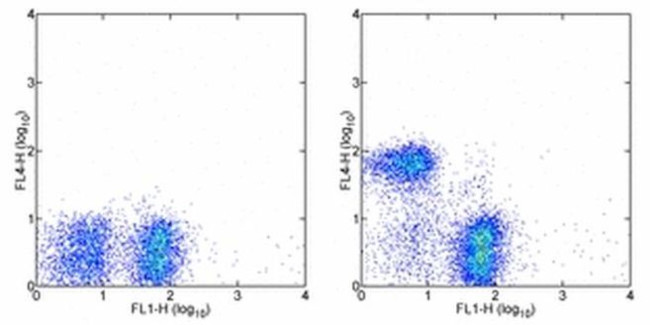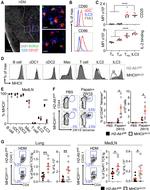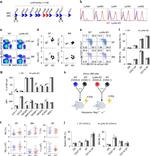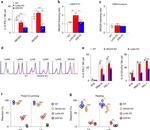Search Thermo Fisher Scientific
Invitrogen
CD3e Monoclonal Antibody (eBio500A2 (500A2)), Alexa Fluor™ 700, eBioscience™
Product Details
56-0033-82
Species Reactivity
Published species
Host/Isotype
Class
Type
Clone
Conjugate
Excitation/Emission Max
Form
Concentration
Purification
Storage buffer
Contains
Storage conditions
Shipping conditions
RRID
Product Specific Information
Description: The eBio500A2 monoclonal antibody reacts with the 25 kD epsilon subunit of the mouse CD3 complex. CD3 subunits gamma, delta and epsilon are required for proper assembly, trafficking and surface expression of the TCR complex. CD3 is expressed by thymocytes in a developmentally regulated manner and by all mature T cells, as well as NKT cells. Binding of eBio500A2 to CD3 initiates the intracellular biochemical pathway resulting in cellular activation and proliferation. The 500A2 antibody is able to partially cross-block the 17A2 and 145-2C11 antibodies, indicating that all three of these anti-CD3 antibodies recognize distinct but overlapping epitopes.
Applications Reported: This eBio500A2 (500A2) antibody has been reported for use in flow cytometric analysis.
Applications Tested: This eBio500A2 (500A2) antibody has been tested by flow cytometric analysis. This can be used at less than or equal to 0.5 µg per test. A test is defined as the amount (µg) of antibody that will stain a cell sample in a final volume of 100 µL. Cell number should be determined empirically but can range from 10^5 to 10^8 cells/test. It is recommended that the antibody be carefully titrated for optimal performance in the assay of interest.
Alexa Fluor® 700 emits at 723 nm and can be excited with the red laser (633 nm). Most instruments will require a 685 LP mirror and 710/20 filter. Please make sure that your instrument is capable of detecting this fluorochrome.
Excitation: 633-647 nm; Emission: 723 nm; Laser: Red Laser.
Filtration: 0.2 µm post-manufacturing filtered.
Target Information
The CD3 subunit complex which is crucial in transducing antigen-recognition signals into the cytoplasm of T cells and in regulating the cell surface expression of the TCR complex. T cell activation through the antigen receptor (TCR) involves the cytoplasmic tails of the CD3 subunits CD3 gamma, CD3 delta, CD3 epsilon and CD3 zeta. These CD3 subunits are structurally related members of the immunoglobulins super family encoded by closely linked genes on human chromosome 11. The CD3 components have long cytoplasmic tails that associate with cytoplasmic signal transduction molecules and this association is mediated at least in part by a double tyrosine-based motif present in a single copy in the CD3 subunits. CD3 may play a role in TCR-induced growth arrest, cell survival and proliferation. The CD3 antigen is present on 68-82% of normal peripheral blood lymphocytes, 65-85% of thymocytes and Purkinje cells in the cerebellum. It is never expressed on B or NK cells. Decreased percentages of T lymphocytes may be observed in some autoimmune diseases. The genes encoding the CD3 epsilon, gamma and delta polypeptides are located on chromosome 11. Defects in the CD3 gene are associated with CD3 immunodeficiency.
For Research Use Only. Not for use in diagnostic procedures. Not for resale without express authorization.
How to use the Panel Builder
Watch the video to learn how to use the Invitrogen Flow Cytometry Panel Builder to build your next flow cytometry panel in 5 easy steps.
Bioinformatics
Protein Aliases: CD247; CD247 antigen; CD3 antigen, zeta polypeptide; CD3 TCR complex; CD3-zeta/eta; CD3d; CD3e; CD3g; FLJ18683; Leu-4; T cell antigen receptor complex epsilon subunit of T3; T-cell receptor T3 delta chain; T-cell receptor T3 eta chain; T-cell receptor T3 gamma chain; T-cell receptor T3 zeta chain; T-cell surface antigen T3/Leu-4 epsilon chain; T-cell surface glycoprotein CD3 delta chain; T-cell surface glycoprotein CD3 epsilon chain; T-cell surface glycoprotein CD3 gamma chain; T-cell surface glycoprotein CD3 zeta chain; T3/TCR complex
Gene Aliases: 4930549J05Rik; A430104F18Rik; AI504783; AW552088; Cd247; CD3; Cd3-eta; Cd3-zeta; Cd3d; Cd3e; CD3epsilon; Cd3g; Cd3h; Cd3z; Cd3zeta; Ctg-3; Ctg3; T3d; T3e; T3g; T3z; Tcrk; Tcrz
UniProt ID: (Mouse) P24161, (Mouse) P04235, (Mouse) P22646, (Mouse) P11942
Entrez Gene ID: (Mouse) 12503, (Mouse) 12500, (Mouse) 12501, (Mouse) 12502

Performance Guarantee
If an Invitrogen™ antibody doesn't perform as described on our website or datasheet,we'll replace the product at no cost to you, or provide you with a credit for a future purchase.*
Learn more
We're here to help
Get expert recommendations for common problems or connect directly with an on staff expert for technical assistance related to applications, equipment and general product use.
Contact tech support





